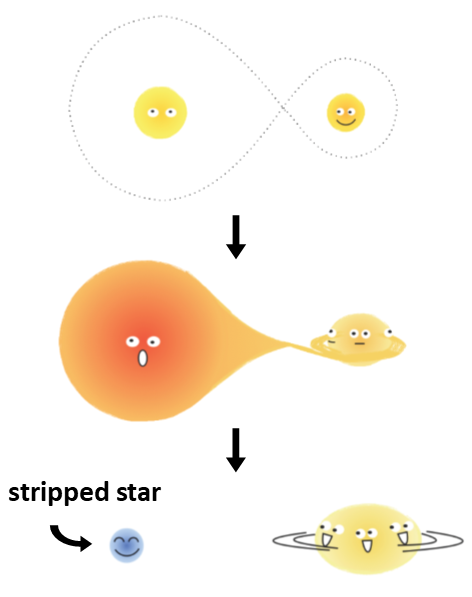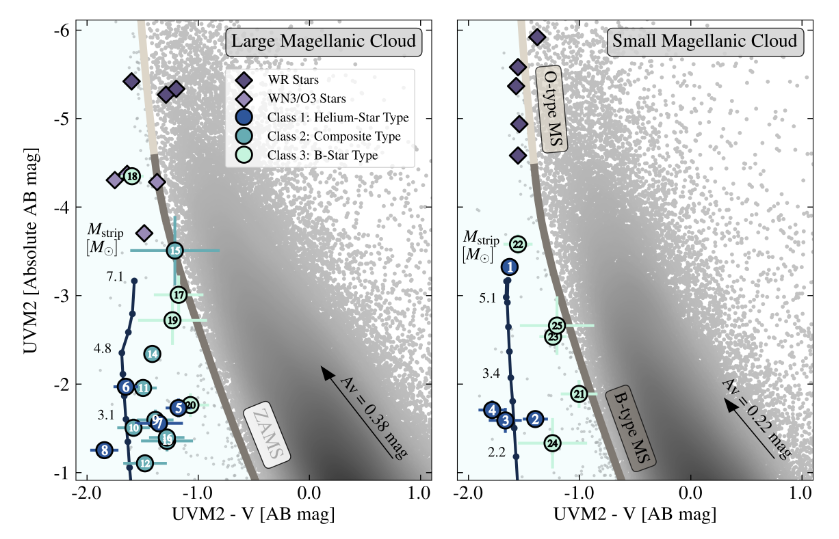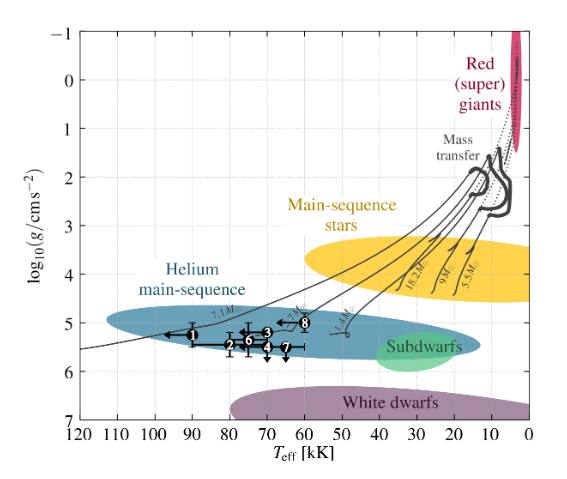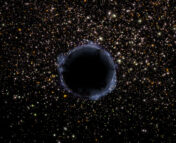Title: Discovery of the missing intermediate-mass helium stars stripped in binaries
Authors: M. R. Drout, Y. Götberg, B. A. Ludwig, J. H. Groh, S. E. de Mink, A. J. G. O’Grady, N. Smith
First Author’s Institution: Department of Astronomy & Astrophysics, University of Toronto, Toronto, Canada & The Observatories of the Carnegie Institution for Science, Pasadena, USA
Status: Published in Science [closed access]
Stars love to hang out with their friends. Nearly half of all Sun-like stars are in binary or higher-order systems; for more massive stars, that fraction increases to over 80%! But these stellar friendships aren’t always smooth sailing. Interactions between massive companions often result in one star being stripped of its hydrogen-rich envelope (see Figure 1). What’s left behind is a “stripped star” – a hot, compact, helium-burning object with only a fraction of its original mass. Though stripped stars are predicted to be fairly common, accounting for nearly one-third of all O-type stars, one important population has (until recently) escaped detection: intermediate-mass stripped stars.

Mind the (mass) gap!
Theoretically, stars of any mass can become stripped. Very massive stars (>=25 solar masses (M☉)) produce so much energy that they strip themselves with their strong stellar winds, while less massive stars (<25 M☉) are usually only stripped through encounters with companions. Although the chance of having a companion decreases with stellar mass, there is no reason to suspect that any given mass range is “unstrippable.”
Unfortunately, this theory has proven difficult to validate with observations. Astronomers have identified hundreds of high-mass stripped stars (Wolf-Rayet stars, >~8 M☉ after stripping) and low-mass stripped stars (hot subdwarfs, <1.5 M☉ after stripping). But as of January 2023, we only knew of one intermediate-mass stripped star (2-8 M☉ after stripping).
Stars in this “mass gap” are thought to be the main source of two key astrophysical processes: neutron star-neutron star mergers and stripped-envelope supernovae. Stripped-envelope supernovae in particular are quite common, accounting for up to one-third of all core-collapse supernovae, so we expect intermediate-mass stripped stars should be common as well. Failure to find more of these stars would mean our understanding of binary evolution is incomplete. Luckily, today’s paper shows that observational bias, not incorrect models, might be to blame for the dearth of detections.
Hiding in plain sight
Stripped stars are hot and bright, but they’re also very small, which limits their total luminosity. In optical wavelengths, the light from stripped stars is drowned out by the light from their much larger main-sequence companions. This is especially true for intermediate-mass stripped stars, which are expected to have O- and B-type companions – the brightest main-sequence stars there are. To get around this issue, the authors of today’s paper try a new technique: searching for objects that show excess ultraviolet (UV) emission.
All stars emit UV radiation, a portion of which is absorbed by their hydrogen-rich outer layers. The authors propose that stripped stars, which lack these outer layers, should appear brighter in the UV than a normal star would. To quantify this difference, the authors created simulations of intermediate-mass stripped stars with MESA, a stellar evolution modeling code. From these simulations, they were able to predict where the elusive stars should fall in a UV-optical color-magnitude diagram (CMD).
Next, the authors used archival images from the Swift-UVOT Magellanic Cloud Survey to calculate UV magnitudes for over 500,000 sources. Sources that fell in the correct place on the CMD were followed up with spectroscopy. After discarding sources whose spectra did not match theoretical predictions, 25 candidates remained. These sources, which perfectly bridge the mass gap between Wolf-Rayet stars and hot subdwarfs on the CMD (see Figure 2), are the first-ever observed sample of intermediate-mass stripped stars!

A trio of types
25 stars might not sound like a lot. But what this sample lacks in size, it makes up for in diversity. The authors group the sources into three distinct classes based on how much flux the stripped star appears to contributes to the spectrum:
- Class 1 (8 objects): Objects whose spectra show strong helium absorption lines (specifically HeII), suggesting that the stripped star is dominating the flux of the system.
- Class 2 (8 objects): Objects whose spectra show a mix of HeII absorption and hydrogen lines, suggesting that the stripped star and its main-sequence companion contribute somewhat equally to the flux of the system.
- Class 3 (9 objects): Objects whose spectra lack HeII absorption but show strong hydrogen lines, suggesting that the main-sequence companion is dominating the flux of the system.
Though B-type main-sequence stars could potentially contaminate Class 3, the authors argue that Classes 1 and 2 cannot be anything other than intermediate-mass stripped stars. Focusing on Class 1 stars, whose spectra are least contaminated by their companions, the authors derive surface gravities and effective temperatures from their observations and compare their results to theoretical predictions. As Figure 3 shows, their measurements fall exactly where we expect them to – smack in the middle of the helium main sequence. The mass gap is no more.

Life in a post-gap world
Filling the mass gap doesn’t just save us from reworking our theories of binary evolution. The stars discovered in this paper are the most likely progenitors of stripped-envelope supernovae and neutron star-neutron star mergers, which are thought to be key sites for the r-process. Studying these stars could therefore help us explain the origin of the universe’s heaviest elements, a question that has puzzled astronomers for decades.
Now that we know how to find intermediate-mass stripped stars, we can expand our search beyond the Magellanic Clouds. Since only a small portion of stripped stars are expected to show a UV excess, there must be many more such objects waiting to be discovered. We just need to figure out where (and how) to look!
Astrobite edited by Will Golay and Clarissa Do O.
Featured image credit: Ylva Götberg




